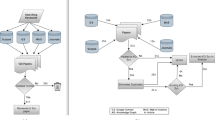Abstract
Pay as you go ontology matching, the technique of first executing an automatic matching tool and then engaging users to improve the quality of an alignment produced by the tool is gaining popularity. Most of the existing techniques employ a single user to validate mappings by annotating them using terms from a controlled set such as “correct” or “incorrect”. This single user based approach of validating mappings using a controlled set of vocabulary is restrictive. First, the use of controlled vocabulary does not maximize the user’s effort since it restrains him/her from adding more meaning to the concepts participating in low-quality mappings using his/her own terms. Secondly, a single user approach of validating a wide range of mappings is error prone since even the most experienced user may not be familiar with all subtopics contained in the input ontologies. We demonstrate in this research that through tagging of concepts participating in mappings flagged as low-quality, we can achieve both mappings’ validation and ontology’s metadata enrichment by adding quality annotations to the ontology.



Similar content being viewed by others
References
Alpert CJ, Yao SZ (1995) Spectral partitioning: the more eigenvectors, the better. In: 32nd design automation conference. IEEE, pp 195–200
Belhajjame K, Paton NW, Fernandes AAA, Hedeler C, Embury SM (2011) User feedback as a first class citizen in information integration systems. In: Conference on innovative data systems research (CIDR 11), pp 175–183
Borgatti SP, Halgin DS (2011) Analyzing affiliation networks. In: Scott J, Carrington PJ (eds) The SAGE handbook of social network analysis. Sage, London, pp 417–433
Cattuto C, Benz D, Hotho A, Stumme G (2008) Semantic analysis of tag similarity measures in collaborative tagging systems. In: Data engineering, p 5
Chan PK, Schlag MD, Zien JY (1994) Spectral K-way ratio-cut partitioning and clustering. IEEE Trans Comput Aided Des Integr Circuits Syst 9:1088–1096
Conroy C, O’Sullivan D, Lewis D (2007) A ’Tagging’ approach to ontology mapping. In: CEUR workshop proceedings, pp 1–5
Cruz IF, Stroe C, Palmonari M (2012) Interactive user feedback in ontology matching using signature vectors. In: Proceedings—international conference on data engineering, pp 1321–1324
Cruz I, Loprete F, Palmonari M (2014) Pay-as-you-go multi-user feedback model for ontology matching. In: International conference on knowledge engineering and knowledge management, pp 80–96
Dang TT, Gabriel A, Hertling S, Roskosch P, Wlotzka M, Zilke JR, Janssen F, Paulheim H (2012) HotMatch results for OEAI 2012. In: CEUR workshop proceedings, pp 145–151
de Vaus D (2002) Surveys in social research. Routledge, Abingdon
Ding CHQ, He X, Zhab H, Gu M, Simon H D (2001) A min–max cut algorithm for graph partitioning and data clustering. In: Proceedings 2001 IEEE international conference on data mining. IEEE, pp 107–114
Dragisic Z, Ivanova V, Lambrix P, Faria D, Jiménez-Ruiz E, Pesquita C (2016) User validation in ontology alignment. In: Proceedings of the international semantic web conference
Eddine W, Tarek M, Ben S (2016) XMap: results for OAEI 2016. In: Proceedings of the 11th international workshop on ontology matching
Euzenat P, Shvaiko J (2007) Ontology matching. Springer, Heidelberg
Groß A, Hartung M, Kirsten T, Rahm E (2012) GOMMA results for OAEI 2012. In: International semantic web conference
Gruber TR (1993) A translation approach to portable ontology specifications. Knowl Acquis 5:199–220
Gulić M, Vrdoljak B, Banek M (2015) CroMatcher—results for OAEI 2015
Hagen L, Member S, Kahng AB (1992) New spectral methods for ratio cut partitioning and clustering. IEEE Trans Comput Aided Des 11(9):1074–1085
Hall KM (1970) An r-dimensional quadratic placement algorithm. Manag Sci 17:219–229
Ipeirotis PG, Provost F, Wang J (2010) Quality management on Amazon Mechanical Turk. In: Proceedings of the ACM SIGKDD workshop on human computation—HCOMP ’10, p 64
Ivanova V, Lambrix P, Å Berg J (2015) Requirements for and evaluation of user support for large-scale ontology alignment. In: Lecture notes in computer science (including subseries lecture notes in artificial intelligence and lecture notes in bioinformatics), pp 3–20
Jiménez-Ruiz E, Grau BC (2011) LogMap: logic-based and scalable ontology matching. In: Lecture notes in computer science (including subseries lecture notes in artificial intelligence and lecture notes in bioinformatics), pp 273–288
Jiménez-Ruiz E, Grau BC, Zhou Y (2011) LogMap 2.0: towards logic-based, scalable and interactive ontology matching. In: SWAT4LS, pp 45–46
Jiménez-Ruiz E, Grau BC, Zhou Y, Horrocks I (2012) Large-scale interactive ontology matching: algorithms and implementation. In: Frontiers in artificial intelligence and applications, no ii, pp 444–449
Jirkovský V, Ichise R (2014) MAPSOM: user involvement in ontology matching. In: Kim W, Ding Y, Kim HG (eds) Semantic technology. JIST 2013. Lecture notes in computer science, vol 8388. Springer, Cham.
Luxburg UV (2006) A tutorial on spectral clustering a tutorial on spectral clustering. Stat Comput 17:395–416
Malik J, Belongie S, Leung TK, Shi J (2001) Contour and texture analysis for image segmentation. Int J Comput Vis (1):7–27. http://citeseerx.ist.psu.edu/viewdoc/summary?doi=10.1.1.14.1476
Massmann S, Raunich S, Aumüller D, Arnold P, Rahm E (2011) Evolution of the COMA match system. In: CEUR workshop proceedings, pp 49–60
Meilicke C (2011) Alignment incoherence in ontology matching. Dissertation—meilicke, Ph.D. dissertation, Universitat Mannheim
Melnik S, Garcia-Molina H, Rahm E (2002) Similarity flooding: a versatile graph matching algorithm. In: Data engineering, pp 117–128
Mika P (2007) Ontologies are us: a unified model of social networks and semantics. Web Semantics, pp 5–15. http://dx.doi.org/10.1016/j.websem.2006.11.002
Mohar B (1988) The Laplacian spectrum of graphs. In: Proceedings of 6th quadrennial international conference on the theory and applications of graphs, pp 871–898
Mohar B (1991) Some applications of Laplace eigenvalues of graphs. In: Graph symmetry: algebraic methods and applications, pp 225–275. http://citeseerx.ist.psu.edu/viewdoc/summary?doi=10.1.1.17.467
Nentwig M, Hartung M, Ngonga A-C, Rahm E (2015) A survey of current link discovery frameworks. Semant Web Interoper Usability Appl J 8:1–17
Ngo DH, Bellahsene Z (2016) Overview of YAM++(not) Yet Another Matcher for ontology alignment task. J Web Semant 41:30–49
Osorno-Gutierrez F, Paton NW, Fernandes AAA (2013) Crowdsourcing feedback for pay-as-you-go data integration. In: CEUR workshop proceedings, pp 32–37
Otero-Cerdeira L, Rodríguez-Martínez FJ, Gómez-Rodríguez A (2015) Ontology matching: a literature review. Expert Syst Appl 42:949–971
Pesquita C, Faria D, Santos E, Couto F M (2013) To repair or not to repair: Reconciling correctness and coherence in ontology reference alignments. In: CEUR workshop proceedings, pp 13–24
Peukert E, Massmann S (2010) Comparing similarity combination methods for schema matching. J GI Jahrestag 1:692–701
Salton G (1989) Automatic text processing: the transformation, analysis, and retrieval of information by computer. Analysis and retrieval of information by computer. Addison-Wesley, Boston
Sánchez D, Batet M, Isern D, Valls A (2012) Ontology-based semantic similarity: a new feature-based approach. Expert Syst Appl 39:7718–7728
Santos E, Faria D, Pesquita C, Couto FM (2015) Ontology alignment repair through modularization and confidence-based heuristics. PLoS ONE 10:1–17
Sarasua C, Simperl E, Noy NF (2012) CrowdMap: crowdsourcing ontology alignment with microtasks. In: Lecture notes in computer science (including subseries lecture notes in artificial intelligence and lecture notes in bioinformatics), vol 7649. LNCS, pp 525–541
Shi F, Li J, Tang J, Xie G, Li H (2009) Actively learning ontology matching via user interaction. In: Lecture notes in computer science (including subseries lecture notes in artificial intelligence and lecture notes in bioinformatics), pp 585–600
Shvaiko P, Euzenat J (2013) Ontology matching: state of the art and future challenges. IEEE Trans Knowl Data Eng 25:158–176
Song Y, Zhang L, Giles CL (2011) Automatic tag recommendation algorithms for social recommender systems. ACM Trans Web 5(1):1–31
Spielman DA, Teng SH (2007) Spectral partitioning works: planar graphs and finite element meshes. Linear Algebra Appl 421(2–3):284–305
Author information
Authors and Affiliations
Corresponding author
Rights and permissions
About this article
Cite this article
Ochieng, P., Kyanda, S. Ontologies’ mappings validation and annotation enrichment through tagging. Artif Intell Rev 52, 2623–2650 (2019). https://doi.org/10.1007/s10462-018-9632-4
Published:
Issue Date:
DOI: https://doi.org/10.1007/s10462-018-9632-4




